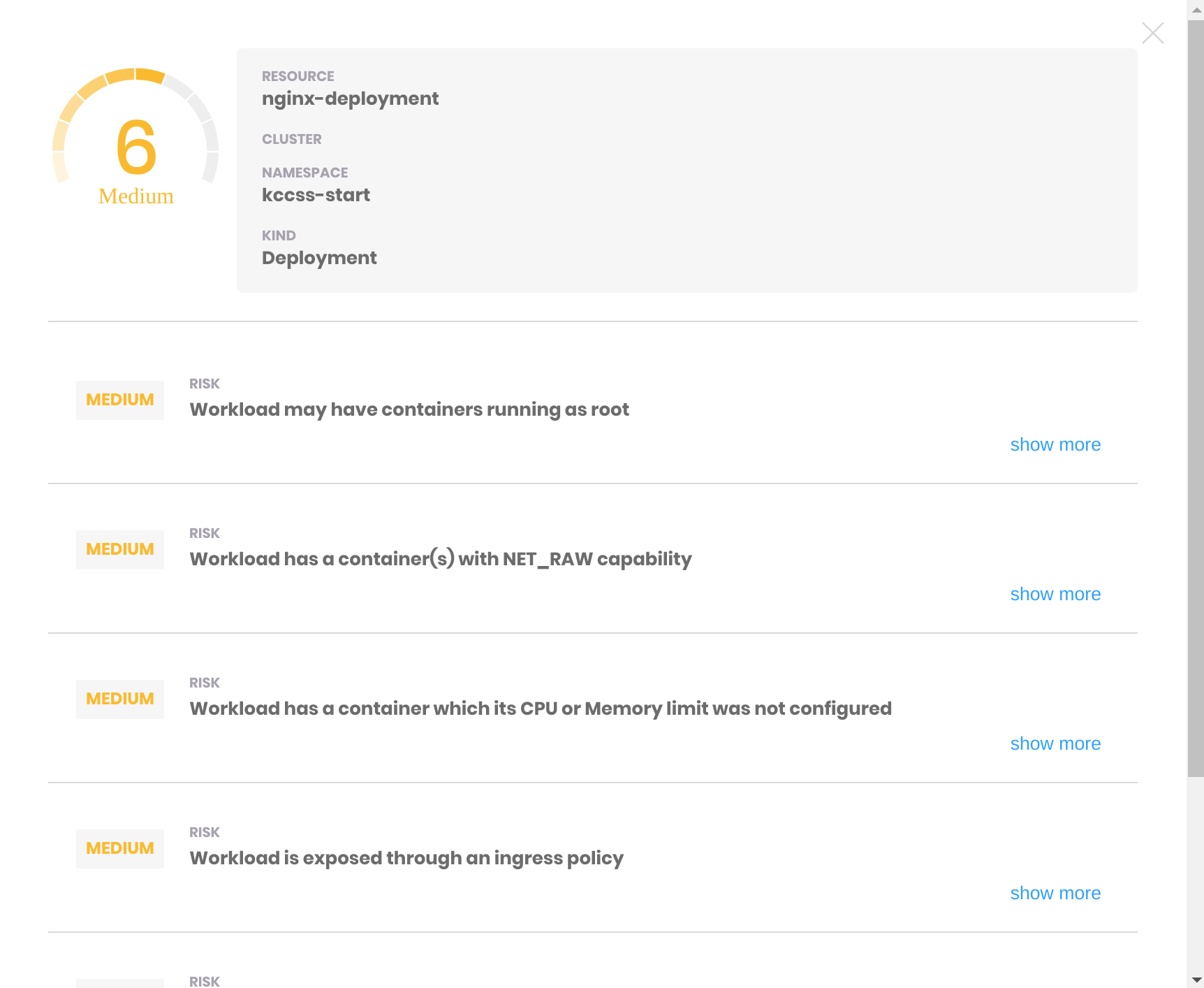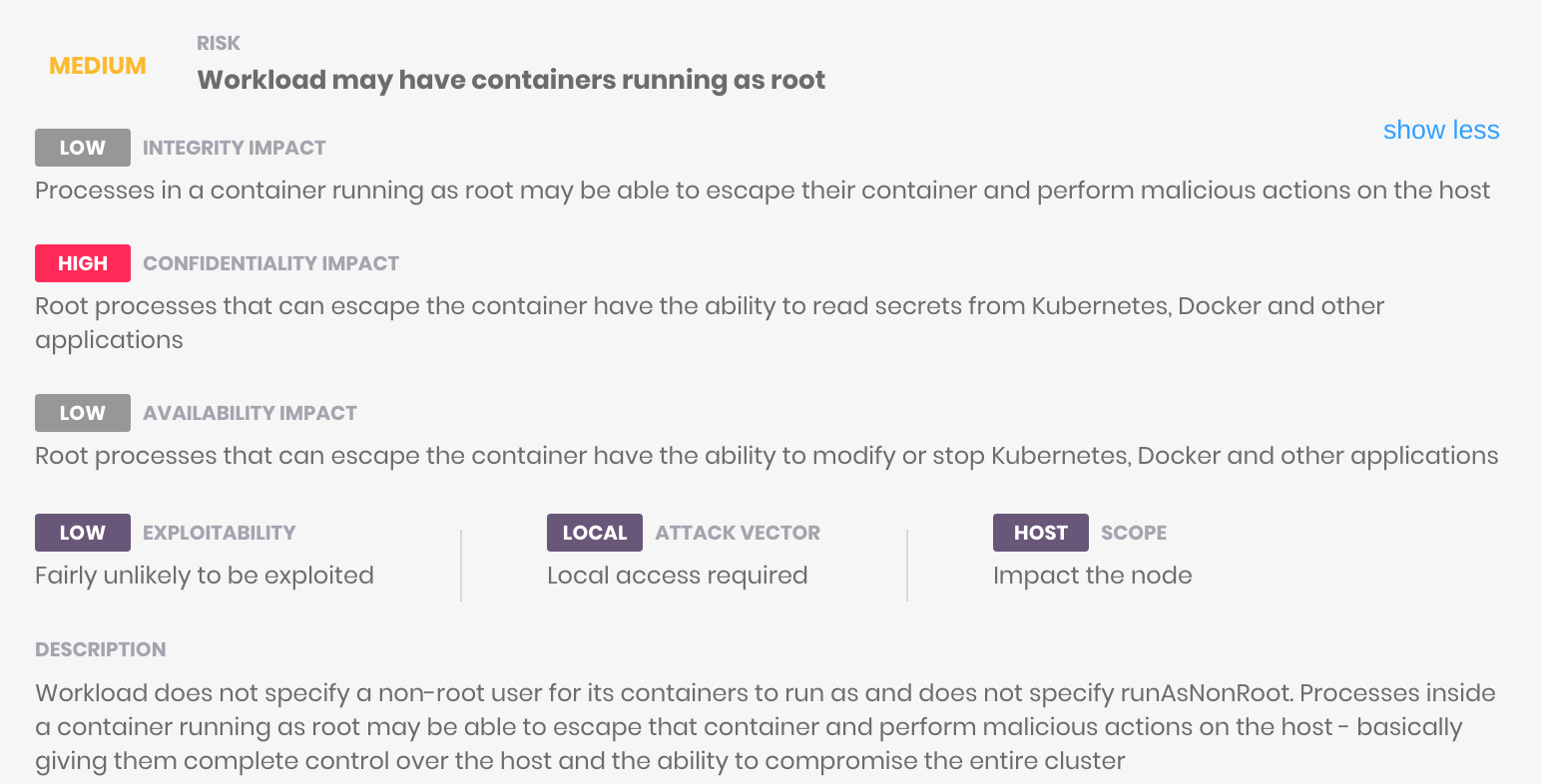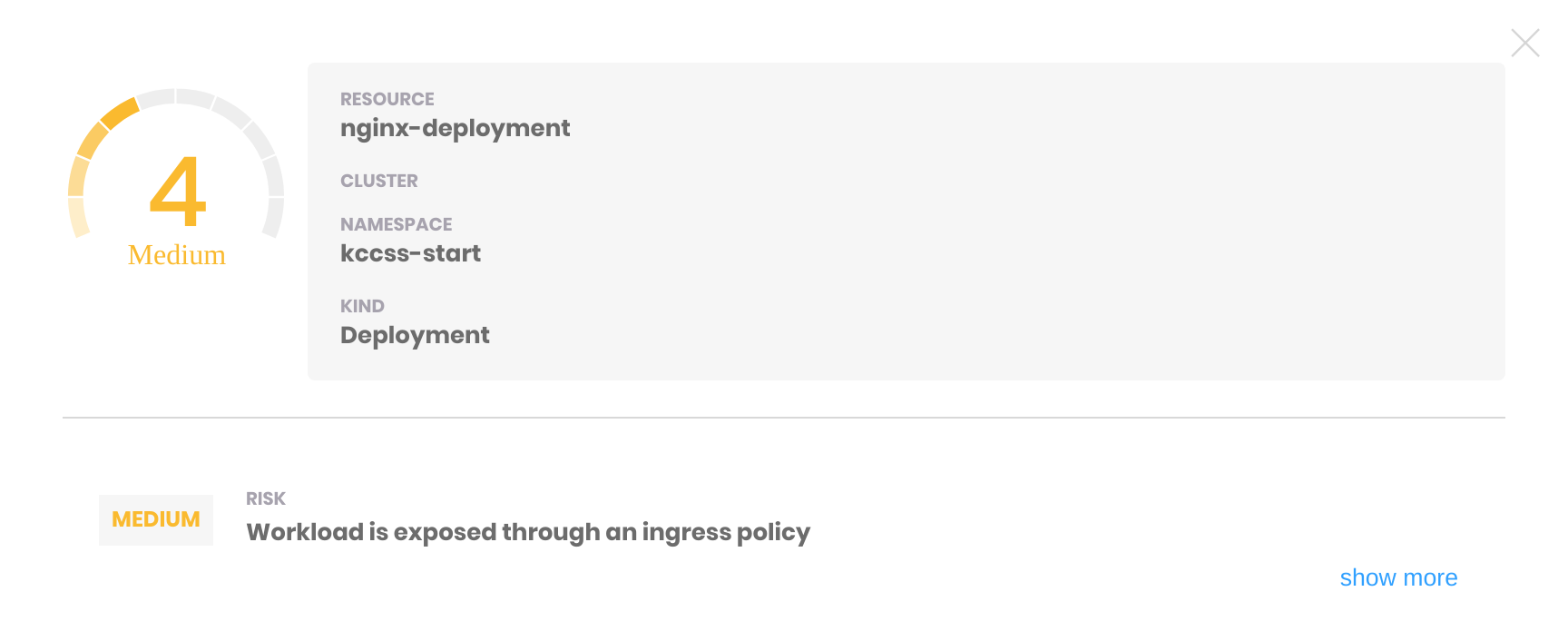Introduction
There are lots of articles explaining what is important and what you should consider to securing your Kubernetes configurations, but I have not found that many guiding you through the steps of implementing these recommendations. And I am not talking about securing the code of the application (this is something that software engineers should be used to) or the containers (this is something for another time).
These recommendations are in the realm of:
- the services in the containers should not run as root
- the containers should not be privileged or be allowed to escalate privileges
- the container file system should be read-only
Introducing the KCCSS and kube-scan
As Kubernetes matures a common language and understanding of securing configurations is important and that is what the Kubernetes Common Configuration Scoring System (KCSS) tries to address, by suggesting a standard way to determine risky workloads due to configurations. The idea if the KCCSS is comparable the Common Vulnerability Scoring System (CVSS), the industry-standard for rating vulnerabilities.
Octarine has implemented kube-scan as a rules-based tool to determine the risk score of a workload and we will use kube-scan with its default rules-set throughout this exercise.
You should install kube-scan from its Github repo if you want to follow along (I have changed the KUBESCAN_REFRESH_STATE_INTERVAL_MINUTES to 1 to speed-up refreshes).
TLDR;
This article will take you step-by-step from an insecure (from the KCCSS point-of-view) configuration to a configuration that is as secure as possible.
Starting-point
This article will take a simple Kubernetes deployment based on Nginx and exposed by an ingress (if your ingress controller is not Traefik you may need to change the kubernetes.io/ingress.class).
Deploy
kubectl create ns kccss-start
kubectl -n kccss-start apply -f https://gist.githubusercontent.com/asksven/224a07ca5723c60f342429f3ce42e3d2/raw/083c79a6e7819c9f8c126a305e29915cf866d65c/deployment-start.yaml
Result
The kube-scan result shows a KCSS score of 6 and lists the following issues:
- Workload may have containers running as root
- Workload has a container with NET_RAW capability
- Workload has a container which its CPU or Memory limit was not configured
- Workload is exposed through an ingress policy
- Workload allows privilege escalation
- Workload has a container(s) with writable file system

Looking into the details - e.g. of “Workload may have containers running as root” - you can find an explanation about the issue as well as hints on how to fix it:

How I got there
We will address the issues one-by-one, incrementally changing the manifest. The end-result shows the result.
Workload may have containers running as root
In order to fix this issue we add securityContext:runAsNonRoot: true to the deployment’s {spec.template.spec.containers}, as well as adding a securityContext to {spec.template.spec}:
spec:
securityContext:
runAsUser: 999
containers:
- image: nginx:latest
imagePullPolicy: Always
name: nginx
ports:
- containerPort: 80
protocol: TCP
securityContext:
runAsNonRoot: true
Re-deploying causes an error:
nginx-deployment-6566d58467-86ns5 0/1 CrashLoopBackOff 6 10m
A closer look shows the problem:
[emerg] 1#1: mkdir() "/var/cache/nginx/client_temp" failed (13: Permission denied)
This shows that not all containers play well with having their permissions restricted. Fortunately, there is an alternative docker image that better suits our needs: nginxinc/nginx-unprivileged. Replacing nginx:latest with nginxinc/nginx-unprivileged in {spec.template.spec.containers.image} fixes the issue. Please also note that we nee to change the containerPort as well as the service’s targetPort to 8080.
This is how the deployment looks like after that first step:
spec:
securityContext:
runAsUser: 999
containers:
- image: nginxinc/nginx-unprivileged:latest
imagePullPolicy: Always
name: nginx
ports:
- containerPort: 8080
protocol: TCP
securityContext:
runAsNonRoot: true
Workload has a container(s) with NET_RAW capability
In order to fix this issue we add securityContext:capabilities.drop: - NET_RAW to the deployment’s {spec.template.spec.containers}:
spec:
securityContext:
runAsUser: 999
containers:
- image: nginxinc/nginx-unprivileged:latest
imagePullPolicy: Always
name: nginx
ports:
- containerPort: 8080
protocol: TCP
securityContext:
capabilities:
drop:
- NET_RAW
runAsNonRoot: true
Workload has a container which its CPU or Memory limit was not configured
In order to fix this issue we add resources.limits and resources.requests to the deployment’s {spec.template.spec.containers}. Pick requests and limits carefully, depending on the docker image and on the real load.
spec:
securityContext:
runAsUser: 999
containers:
- image: nginxinc/nginx-unprivileged:latest
imagePullPolicy: Always
name: nginx
ports:
- containerPort: 8080
protocol: TCP
securityContext:
capabilities:
drop:
- NET_RAW
runAsNonRoot: true
resources:
limits:
cpu: "100m"
memory: "10Mi"
requests:
cpu: "80m"
memory: "4Mi"
Workload is exposed through an ingress policy
Well, that is funny because this is the whole purpose of having a webserver: there is nothing we can do about this issue. I think that is an area where kube-scan (tested on v20.1.1) could improve as networking is not black and white: network policies should be put in place to restrict the traffic to and from the workload to a minimum:
- deny inbound traffic not coming from the ingress controller
- deny outbound traffic completely as our workload does not need any
This collection of network policy receipes is a good starting point. When denying outbound traffic always keep in mind that DNS queries (to CoreDNS) must be taken into account.
For our namespace we will add two network policies:
apiVersion: networking.k8s.io/v1
kind: NetworkPolicy
metadata:
name: web-allow-ingress
spec:
podSelector:
matchLabels:
app: nginx
ingress:
- ports:
- port: 80
- from:
- namespaceSelector:
matchLabels:
purpose: ingress
---
kind: NetworkPolicy
apiVersion: networking.k8s.io/v1
metadata:
name: default-deny-all-egress
spec:
policyTypes:
- Egress
podSelector: {}
egress: []
These have the following effects:
web-allow-ingressgrants inbound traffic coming from the namespace labeledpurpose=ingresson port 80 (my ingress controller sits in thetraefiknamespace and has been labeled accordingly:kubectl label namespace/traefik purpose=ingress)default-deny-all-egressdenies any outbound (egress) traffic
Workload allows privilege escalation
Not that we have our container running as non-root this issue can be resolved by adding allowPrivilegeEscalation: false to {spec.template.spec.containers}:
spec:
securityContext:
runAsUser: 999
containers:
- image: nginxinc/nginx-unprivileged:latest
imagePullPolicy: Always
name: nginx
ports:
- containerPort: 8080
protocol: TCP
securityContext:
capabilities:
drop:
- NET_RAW
runAsNonRoot: true
allowPrivilegeEscalation: false
resources:
limits:
cpu: "100m"
memory: "10Mi"
requests:
cpu: "80m"
memory: "4Mi"
Workload has a container with writable file system
Not that we have our container running as non-root this issue can be resolved by adding readOnlyRootFilesystem: true to {spec.template.spec.containers}:
spec:
securityContext:
runAsUser: 999
containers:
- image: nginxinc/nginx-unprivileged:latest
imagePullPolicy: Always
name: nginx
ports:
- containerPort: 8080
protocol: TCP
securityContext:
capabilities:
drop:
- NET_RAW
runAsNonRoot: true
allowPrivilegeEscalation: false
readOnlyRootFilesystem: true
resources:
limits:
cpu: "100m"
memory: "10Mi"
requests:
cpu: "80m"
memory: "4Mi"
Here again, re-deploying causes an error:
nginx-deployment-54bdd6796f-wlxkv 0/1 CrashLoopBackOff 4 2m6s
A closer look shows the problem:
[emerg] 1#1: mkdir() "/tmp/proxy_temp" failed (30: Read-only file system)
nginx: [emerg] mkdir() "/tmp/proxy_temp" failed (30: Read-only file system)
This is due to readOnlyRootFilesystem: true so to fix this we need a workaround. As Nginx needs to create directories in /tmp we need to make this writable. We don’t want to create persistent volumes for each pod so we will mount /tmp to emptyDir instead:
spec:
securityContext:
runAsUser: 999
containers:
- image: nginxinc/nginx-unprivileged:latest
imagePullPolicy: Always
name: nginx
ports:
- containerPort: 8080
protocol: TCP
securityContext:
capabilities:
drop:
- NET_RAW
runAsNonRoot: true
allowPrivilegeEscalation: false
readOnlyRootFilesystem: true
resources:
limits:
cpu: "100m"
memory: "10Mi"
requests:
cpu: "80m"
memory: "4Mi"
volumeMounts:
- mountPath: /tmp
name: tmp
volumes:
- emptyDir: {}
name: tmp
The final result
The final deployment can be found here.
The end result is a KCCSS of 4:

Conclusion
Securing Kubernetes configurations is not that simple, and all changes can not be applied to the manifests: if docker images do not play nice securing your configurations will require changes to your Dockerfiles as well.
The exercise is pretty tedious as well: imagine a more complex workload, with tens of containers where you would have to go through the same exercise. Pod security policies may help establish better standards and defaults in the future, even if their future seems uncertain. Projects like kyverno and Open Policy Agent’s Gatekeeper are alternatives and it seems that the community is leaning toward OPA.